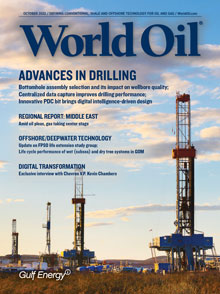Issue: October 2022
Features
An ABS-led consortium has spent the last year identifying operational and safety challenges with aging FPSOs. For the future, these challenges require changes in the design phase to mitigate some issues and costs for retrofitting and further changes.
Using advanced snubbing equipment has enhanced completion and workover efficiencies in developing Vaca Muerta shale resources. The new hydraulic completion units increase performance and enable the operator to push the technical limits of extended lateral well completions.
Much is at stake in these elections that could help or hurt the health of the U.S. upstream sector. This will be the first election affected by the redistricting that followed the 2020 census. The Republicans are favored to retake a majority in the House, but control of the Senate remains a “tossup.”
In this exclusive interview, Chevron’s V.P. for Subsurface gauges the industry’s efforts to more thoroughly harness digital technology and discusses his own company’s projects to bring digital benefits to all its operations.
With a contentious cohort largely sidelined, the Saudi Arabia-led OPEC+ alliance is reinforcing a hard truth: the coalition is firmly in control of the global oil market.
This first article of a three-part series introduces the basis and results of 30-year lifecycle operation simulations performed to compare a subsea (wet tree) hub and spoke scheme to a dry tree phased approach using Frontier’s concepts to develop major discoveries in the ultra-deep high-pressure Gulf of Mexico.
The latest round of EPA regulations may mandate zero emission devices for well sites, but this issue can be addressed by a variety of automation solutions to meet those standards, while improving profitability.
As companies adopt new technologies to make business more effective and efficient, new risks emerge, and old risks evolve. This requires great cybersecurity that has tools and processes built to adapt to change with minimal effort.
Special Focus: Advances in Drilling
In U.S. land drilling, BHA selection frequently uses heuristics derived from motivations of the directional contractor as opposed to incentives for the operator. The authors propose alternatives that balance the needs of the directional company with the operator’s desire for a high-quality wellbore.
Centralized real-time, multidisciplinary data capture platform improves drilling performance
A new modeling system enabled PDC bit designers to increase cutter efficiency and reduce susceptibility to impact damage by optimizing back rake in the nose and shoulder areas. Engineers used the data to update the bit’s torque and efficiency response, resulting in record-high ROP.
Columns
(WO) — Within a few days after this issue is distributed to you, we will once again be upon another fateful moment in U.S. history—the 2022 mid-term elections. Accordingly, we ask the understanding of our loyal readers outside the U.S., for this momentary indulgence.
The concept of nanobubbles was not proposed until 1994, to explain the underpredicted attractive forces observed between hydrophobic surfaces in water. Their existence in a solution, or even if that were accepted, their ability to maintain their size and suspension in a solution, has been the subject of controversy and considerable experimentation.
In February, Russia initiated its unwarranted invasion of Ukraine and ignited an international energy crisis. Immediately thereafter, it appeared that the world and the U.S. would realize the mistakes made in relying on Russian O&G and on unreliable, expensive renewable energy.
The David Bowie song referenced in the headline comes to mind as we look at how produced water management will be evolving. This evolution, however, is happening quicker than some have predicted.
In this time of continuing uncertainty, one thing is certain: a healthy oil and natural gas industry is good for America—bolstering the economy and national security.
Since day one, the Biden administration has set the U.S. on a path toward more reliance on foreign energy from countries with lower environmental standards. Caving to green activists, President Biden launched an overly aggressive environmental campaign designed to phase out the U.S. hydrocarbon industry and the immense value it provides our country in terms of energy independence and employment opportunities.
Resources



